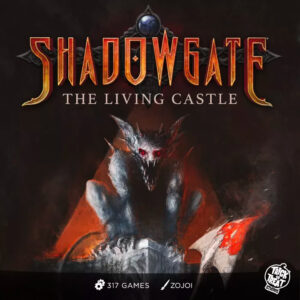 Dungeon crawlers are great. Everyone loves dungeon crawlers, right? Right? Ok, that maybe overstating it, but they are a popular genre. There are many examples that have been, or continue to be, popular over the years: HeroQuest, Descent, Gloomhaven, and more. If there is one thing that makes people hesitant to pick up those sorts of games, though it is the potential complexity of setup and lengthy game time. What if those issues could be solved by making the dungeon crawl based on cards? That’s what Shadowgate: The Living Castle tries to answer.
Dungeon crawlers are great. Everyone loves dungeon crawlers, right? Right? Ok, that maybe overstating it, but they are a popular genre. There are many examples that have been, or continue to be, popular over the years: HeroQuest, Descent, Gloomhaven, and more. If there is one thing that makes people hesitant to pick up those sorts of games, though it is the potential complexity of setup and lengthy game time. What if those issues could be solved by making the dungeon crawl based on cards? That’s what Shadowgate: The Living Castle tries to answer.
Based upon the Shadowgate video games and novels from the 1990s onward, it is a semi-cooperative game for 2-4 players, which takes 45 minutes to an hour to play. The best experience is with 3 players.
Gameplay Overview:
As I alluded to, Shadowgate is a take on the dungeon crawler genre, but played entirely with cards. Throughout the game, you will acquire items, equip them to power yourself up, gain more magic, and complete encounters and quests. All the while, your party delves deeper into the dungeon, uncovering greater challenges, and ultimately, the final boss. This seems like it should be a cooperative endeavor, but is in reality only semi-cooperative, as you are ultimately competing for a higher score at the end of the game.
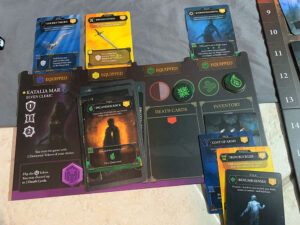
As you might expect from a dungeon, you cannot confront the final boss right away. You have to work your way down to it. As you complete quests from the “first level” you will eventually unlock a second set of more challenging quests. This second set contains a way to unlock a third set, and the third set opens up the final boss itself. It is also a race against time, as every round, your party’s torch burns, and when it burns out the dangers of the dungeon are no longer kept at bay. And you die. Fortunately, death is merely a minor setback. Throughout the game, you will die. You will die a lot.
Each of your turns is a series of phases, but most of them are very simple and quick to execute (frequently, many of them are skipped). At the start of your turn, you can move cards around between your inventory and your equipped item slots, which can alter your stats and give you special abilities prior to undertaking quests. You then have the opportunity to use various actions/abilities on your items and character prior to undertaking quests. All of these first two steps are preparation for the quests which represent the main part of each of your turns. Attempting and completing quests is both the most important part of your turn, and often the most complicated, at least later in the game. Your ability to complete quests is based on your stats, and when they fall short, a roll of the dice. You also can acquire other cards to modify the attempt. After attempting quests, you have one final opportunity to use actions and abilities before your turn ends. That’s actually pretty much it. The complexity is fairly low.
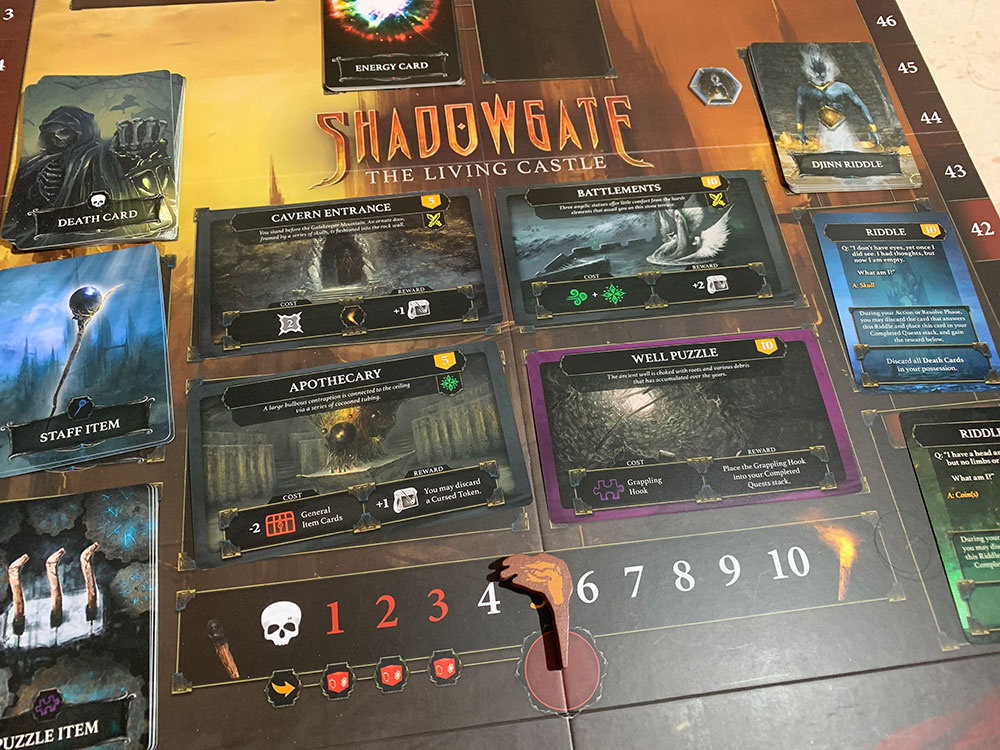
Game Experience:
When I said, some parts of the turn are frequently skipped, that will often apply to the Equip phase at the beginning of your turn. Once you get some good items, you are prone to keeping the same things equipped, unless you know for sure you will need something a bit different from your inventory for the quest. Similarly, the second Action phase after the quests often ends up being skipped as well. There are certain times when the ability to perform a few more actions at that point is helpful, but it doesn’t happen every turn.
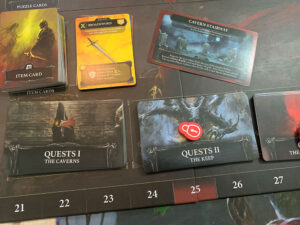
The Quest phase is the core of the game, and it is the phase you are preparing for every turn. Rightly so, because quests are how you are going to complete your objective. The Quest I stack conceals an Event card that opens up the Quest II stack. The Quest II stack has an Event that opens up Quest III, Quest III’s stack is how you will access the Final Boss. Therefore, searching through the quests (you are allowed to “cycle” quests back into their stack to get more if you are unable to do the ones currently available… or you want to prevent someone else from doing them!) and completing them is necessary to advance the game. More than just being necessary to advance to the endgame, however, completing quests can be very lucrative. They give you various rewards, nearly all of which are helpful. Loot gives you ways to boost your stats, and special kinds of loot are necessary for completing different quests later (there are Puzzle Quests in the stack that can only be completed by Puzzle Items you can acquire from rewards).
So how does this important aspect of the game work? Pretty simply. Each quest has a requirement listed. For standard quests, it’s just a value of one or more stats that you need to meet. If your matching stat(s) are too low, you roll a couple of dice, with successes on the dice adding to your appropriate stat for the quest. If your number is high enough, you complete the quest and claim the reward (additionally, you place the quest on your player board to contribute to endgame scoring… very important). If it is too low, you fail and receive a penalty which can include dying on the spot! Some quests might have icons indicating cards that you also must discard if you match the stat component of the quest, and you can’t succeed/claim the reward without them as well.
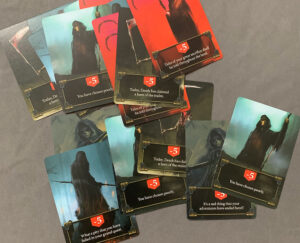
As is appropriate in dungeons, there are different tasks you can complete beyond these standard quests as well. Djinn appear, which offer you riddles to answer for rewards. There are spells and spell tokens that you can use to help with quests, or use to gain points. There are monsters that sometimes come up in place of standard quests, which offer slightly different challenges. It is enough to keep the game a bit varied from start-to-finish, and keep your options open.
Once you have delved deep enough into the dungeon and as a group completed the powerful artifact to unlock the boss’s lair, you may descend and face the boss itself! This final phase of the game is completely different than the rest. In turn, each player trades attacks with the boss. This part is a lot of dice rolling, and has the potential for even more deaths. It does feel a little dramatic since it is a departure from the rest of the game, but it almost felt like the weakest part of the game to me, as the options are a lot more straightforward and your goal is clear. The boss’s health total is also high enough that it can get a tad repetitive.
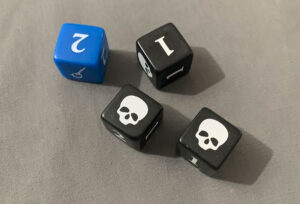
I’ve mentioned a few times that you will be dying a lot here. Normally, dying in games is pretty much the end. Not so here. You draw a Death card and just keep playing. Death cards are nothing fancy. They are just a notation of how many times you have died (tokens or even a tracker might have been better). They are still meaningful in that you lose 5 XP from your final score for each Death card you have, but that’s just a flesh wound, right? In the oddly named “Competition” mode, accruing 5 deaths knocks you out of the remainder of the game, but not in the Standard mode. I found that naming convention odd, as the entire game is ultimately competitive. Competition mode just felt like a “hard mode.”
Ultimately, your goal is not only to defeat the final boss, but also have the most XP from completed quests, riddles, items, and such. This leads to some subtle messing with the other players over the course of the game (such as, cycling a quest you don’t intend to complete, but you don’t want someone else to complete either). I’m not sure it was really necessary, as I felt the game could have stood on its own as a more fully formed cooperative experience if this aspect had been eliminated and the design was slightly modified to account for the change.
Final Thoughts:
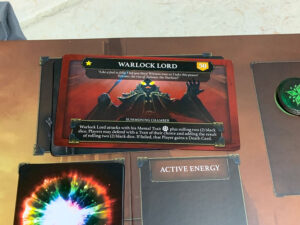
As far as the original question from the intro, does Shadowgate: The Living Castle work as a dungeon crawler with just cards? I think the answer is yes. It feels like a dungeon crawler despite the lack of an actual physical dungeon on the board, and it does not require a spreadsheet with advanced mathematics like Gloomhaven or similar (kidding… mostly). It succeeds very well at what it tries to do in that respect.
Where it does not succeed so well is by trying to turn it into a competitive game. The XP scoring felt like a pretty weak part of the game to me. Perhaps the weakest part. Unfortunately, that aspect is woven throughout the game. You are incentivized to do different tasks for XP. You can get XP bonuses by discarding magic items when you complete quests. Doing more damage to the boss gets you more XP. And so on. This could be my ignorance of the source material, but it is the one aspect that just does not feel like it lands. A party working together to defeat the dungeon and its boss is compelling enough cooperative gameplay that the XP race just feels like an unnecessary extra. It feels more forced than even the competitive aspect of Pirates of Skydock.
The other issue I felt with it was while there is variety within a single game of the quests you can complete and the tasks you can do, overall there isn’t enough variety to make many repeat plays appealing. You go through most or all of the Quest I and Quest II stacks every game, and a good portion of the Quest III stack. This could probably be solved with expansions if there ever are any, but I would have liked to see a bit more variety in the box itself. Having a replayable game out of the box is important.
Not to end on a negative note, I did enjoy the game. It is fast to learn and play, and it does the genre it is referencing justice. If you don’t like the scoring aspect, you could certainly try to ignore it and just work together to try to defeat the boss, which is what I might consider in the future. If they do expansions that increase the variety of options, I would be willing to give those a look as well. The game does have some potential.
Final Score: 3 Stars – A fun, simple pseudo dungeon crawler that is held back by a couple of key issues.
 Hits:
Hits:
• The gameplay is simple, and easy to execute after a turn or two
• The essence of a dungeon crawl is captured pretty well for having no actual dungeon!
• The many ways to die add an element of humor
Misses:
• Endgame scoring ultimately detracts from the game. Would probably have been better as fully cooperative, instead of semi-cooperative with scoring.
• The final boss can be a little tedious
• Could use more variety of quests & bosses























Sort of reminds me of Thunderstone Quest. Sure it’s competitive, but nobody seems to actually care about the scoring and just enjoys the play loop.